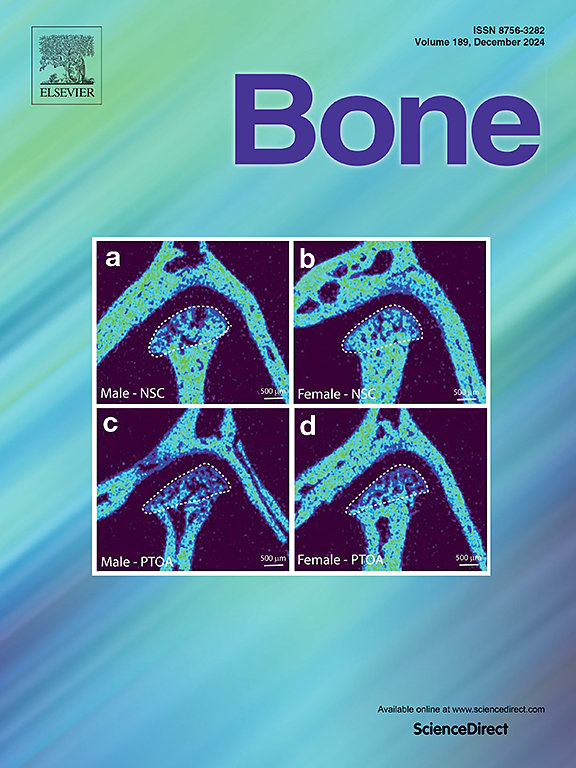Visualization and quantification of RANK-RANKL binding for application to disease investigations and drug discovery
IF 3.5
2区 医学
Q2 ENDOCRINOLOGY & METABOLISM
引用次数: 0
Abstract
Receptor activator of NFκB (RANK)-receptor activator of NFκB ligand (RANKL) binding triggers the differentiation of osteoclasts, bone-resorbing cells. The imbalance between bone resorption by osteoclasts and bone formation by osteoblasts causes bone diseases. We herein report the real-time detection of RANK-RANKL binding using the NanoLuc method. Large-BiT-RANK and RANKL-Small-BiT fusion proteins were expressed in HeLa cells, and their co-culture exhibited chemiluminescence in the presence of luciferase substrates. This luminescence was inhibited by the treatment of cells with an anti-RANKL neutralization antibody, indicating that luminescence is dependent on RANK-RANKL binding. Moreover, mutations in RANKL (M198K or G278R) and RANK (G54R or K171G), based on mutations in autosomal recessive osteopetrosis (ARO) patients, did not exhibit the luminescence in the presence of their wild-type counterparts. HeLa cells expressing RANKL mutants did not support osteoclastogenesis. These results clearly indicate that the loss of binding by RANK-RANKL mutants is responsible for osteoclast-poor osteopetrosis in ARO patients. A nuclear factor kappa B reporter gene assay showed the impaired signal transduction of RANK (G54R) by RANKL. Therefore, our method successfully detected and quantified RANK-RANKL binding in living cells. Furthermore, our method is not only useful for investigating the mechanisms underlying osteoclast-poor ARO, but also for the screening of lead compounds that inhibit RANK-RANKL binding in osteoporosis patients. We identified a new compound with a three-dimensional structure that inhibits RANK-RANKL binding using our method. Our detection system for RANK-RANKL binding will contribute to both the development of anti-osteopetrosis drugs and a more detailed understanding of bone cell biology.

可视化和量化RANK-RANKL结合在疾病调查和药物发现中的应用
nf - κ b受体激活因子(RANK)- nf - κ b配体受体激活因子(RANKL)结合可触发破骨细胞、骨吸收细胞的分化。破骨细胞的骨吸收和成骨细胞的骨形成之间的不平衡导致骨疾病。本文报道了利用NanoLuc方法实时检测RANK-RANKL结合的方法。在HeLa细胞中表达了Large-BiT-RANK和RANKL-Small-BiT融合蛋白,它们的共培养在荧光素酶底物存在下表现出化学发光。这种发光被抗rankl中和抗体处理的细胞抑制,表明发光依赖于RANK-RANKL结合。此外,基于常染色体隐性骨质疏松症(ARO)患者突变的RANKL (M198K或G278R)和RANK (G54R或K171G)突变在其野生型对应体存在时不表现出发光。表达RANKL突变体的HeLa细胞不支持破骨细胞发生。这些结果清楚地表明,RANK-RANKL突变体的结合缺失是ARO患者破骨细胞匮乏的骨质疏松的原因。核因子κ B报告基因检测显示RANKL对RANK (G54R)的信号转导受损。因此,我们的方法成功地检测和量化了活细胞中RANK-RANKL的结合。此外,我们的方法不仅有助于研究破骨细胞缺乏的ARO的机制,而且还有助于筛选骨质疏松症患者中抑制RANK-RANKL结合的先导化合物。我们用我们的方法鉴定了一种具有三维结构的抑制RANK-RANKL结合的新化合物。我们的RANK-RANKL结合检测系统将有助于抗骨质疏松药物的开发和更详细地了解骨细胞生物学。
本文章由计算机程序翻译,如有差异,请以英文原文为准。
求助全文
约1分钟内获得全文
求助全文
来源期刊

Bone
医学-内分泌学与代谢
CiteScore
8.90
自引率
4.90%
发文量
264
审稿时长
30 days
期刊介绍:
BONE is an interdisciplinary forum for the rapid publication of original articles and reviews on basic, translational, and clinical aspects of bone and mineral metabolism. The Journal also encourages submissions related to interactions of bone with other organ systems, including cartilage, endocrine, muscle, fat, neural, vascular, gastrointestinal, hematopoietic, and immune systems. Particular attention is placed on the application of experimental studies to clinical practice.
 求助内容:
求助内容: 应助结果提醒方式:
应助结果提醒方式:


